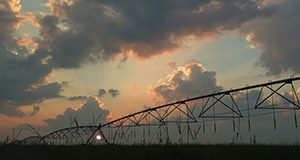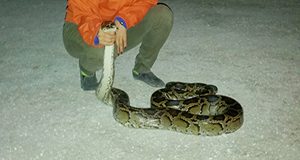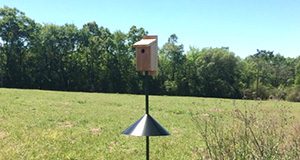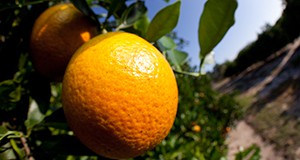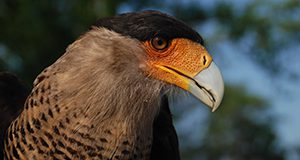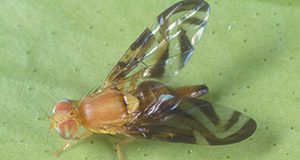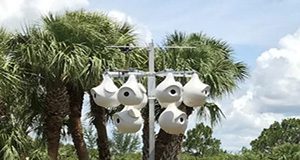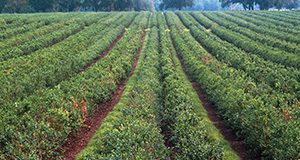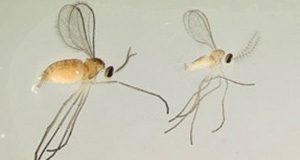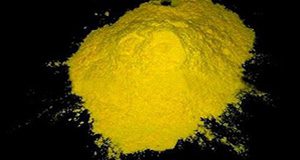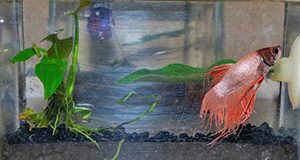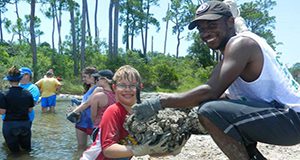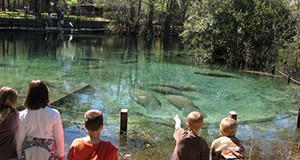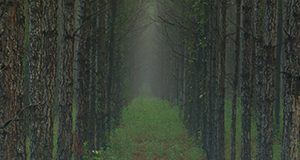Water resources provide us with a variety of goods and services (altogether often referred to as ecosystem services or environmental services.) Part of a series entitled Economic Value of Florida Water Resources, this 5-page fact sheet written by Tatiana Borisova, Syed Irfan Ali Shah, Tara Wade, Kelly Grogan, and Xiang Bi and published by the UF/IFAS Food and Resource Economics Department assesses the economic value of the ecosystem services provided by irrigation water and shows the importance to agriculture of water resource protection and restoration.
http:edis.ifas.ufl.edu/fe1057
Author: Susan Gildersleeve
Early Detection and Rapid Response (EDRR) to Nonnative Wildlife in South Florida
Invasive nonnative wildlife threaten successful restoration of Everglades ecosystems in south Florida. If nothing is done while an invasion is in the beginning stages, populations can grow and become much more difficult to manage, as happened with the Burmese pythons. This 4-page fact sheet written by Justin R. Dalaba and Frank J. Mazzotti and published by the UF/IFAS Wildlife Ecology and Conservation Department explains how the Early Detection and Rapid Response method works and how to apply it to increase the likelihood that an invasion will be successfully contained or eradicated while an invasive population is still small and localized.
http://edis.ifas.ufl.edu/uw454
How to Promote Bluebirds in North Florida
Cavity-nesting eastern bluebirds use naturally occurring holes in trees, cavities hollowed out by woodpeckers, or man-made houses. You can maximize your chances of attracting bluebirds long-term by providing appropriate housing options and locating the houses in suitable sites. This 3-page fact sheet written by Holly K. Ober and published by the UF/IFAS Department of Wildlife Ecology and Conservation provides recommendations on housing for bluebirds in north Florida.
http://edis.ifas.ufl.edu/uw451
Wildlife of Florida Factsheet: Northern Bobwhite Quail
The Wildlife of Florida Factsheet series was created to provide the public with a quick and accurate introduction to Florida’s wildlife, including both native and invasive species. Authors Tyler Buckley and Raoul Boughton hope this 2-page fact sheet published by the UF/IFAS Department of Wildlife Ecology and Conservation will inspire people to learn more about the northern bobwhite quail and understand the amazing biodiversity of wildlife in general in the state of Florida and in their own backyards and communities.
http://edis.ifas.ufl.edu/uw455
Cost of Producing Processed Oranges in Southwest Florida in 2017/18
This 4-page fact sheet written by Ariel Singerman and published by the UF/IFAS Food and Resource Economics Department presents a summary of the 2017/18 costs of production for processed oranges grown in southwest Florida. Typical users of these estimates include growers and consultants, who use them as a benchmark; property appraisers, who use them to compute the taxes for property owners; and researchers, who use the estimates to evaluate the economic feasibility of potential new technologies.
http://edis.ifas.ufl.edu/fe1056
Wildlife of Florida Factsheet: Northern Crested Caracara
The Wildlife of Florida Factsheet series was created to provide the public with a quick and accurate introduction to Florida’s wildlife, including both native and invasive species. Authors Elizabeth Rose and Raoul Boughton hope this 2-page fact sheet published by the UF/IFAS Department of Wildlife Ecology and Conservation will inspire people to learn more about the northern crested caracara and understand the amazing biodiversity of wildlife in general in the state of Florida and in their own backyards and communities.
http://edis.ifas.ufl.edu/uw452
Caribbean Fruit Fly Management in Florida Peaches
The Caribbean fruit fly, Anastrepha suspensa, is a member of the fly family Tephritidae, which contains some of the most destructive fruit pests in the world. This 4-page fact sheet written by Amanda Coleen Hodges and Cory Penca and published by the UF/IFAS Department of Entomology and Nematology provides information about the biology and management of the Caribbean fruit fly.
http://edis.ifas.ufl.edu/in1242
Cost Estimates of Producing Sugar Apple (Annona squamosa L.) in South Florida
Because of the growing interest in alternative tropical fruit crops to diversify farm income, this 6-page fact sheet written by Fredy H. Ballen, Aditya Singh, Edward Evans, and Jonathan Crane and published by the UF/IFAS Food and Resource Economics Department offers an estimate of costs and returns associated with operating an established sugar apple orchard in south Florida.
http://edis.ifas.ufl.edu/fe1053
How to Promote Purple Martins in North Florida
Purple Martins are highly social, cavity-nesting birds. In the Eastern United States, a shortage of natural housing options has left these fascinating and attractive birds completely dependent on man-made housing. Author Holly K. Ober tested seven commercially available martin houses to determine what is best for martins in north Florida and provides recommendations in this 4-page fact sheet published by the UF/IFAS Department of Wildlife Ecology and Conservation.
http://edis.ifas.ufl.edu/uw450
Crop Insurance Policies Available to Blueberry Growers in Florida
The main source of risk in crop production stems from the unpredictable nature of weather, pests, diseases, etc. By purchasing crop insurance, the farmer transfers part of the risk to an insurance company in exchange for paying a premium (which is the cost of purchasing crop insurance). In this 6-page fact sheet published by the UF/IFAS Food and Resource Economics Department, authors Robert Ranieri and Ariel Singerman describe and provide examples for the two main crop insurance policies available for blueberry farmers in Florida.
http://edis.ifas.ufl.edu/fe1054
Blueberry Gall Midge on Southern Highbush Blueberry in Florida
Blueberry gall midge is a small fly native to North America that feeds on blueberries and cranberries. It can be found throughout the United States, including Florida, where its larvae feed on southern highbush blueberry and rabbiteye floral and vegetative buds. Reports of blueberry gall midge damage on southern highbush blueberry in Florida have become more common in recent years, in some cases significantly impacting yield where there was severe feeding damage to floral buds. This 3-page fact sheet written by Oscar Liburd and Doug Phillips and published by the UF/IFAS Department of Entomology and Nematology will inform growers how to scout for, identify, and control blueberry gall midge.
http://edis.ifas.ufl.edu/in1239
Microworm Culture for Use in Freshwater Ornamental Aquaculture
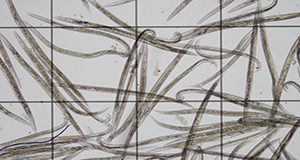
A small nematode worm commonly referred to as a “microworm” has been a staple live feed used in the ornamental aquaculture industry for over 50 years. These worms are small enough to be ingested by the larvae of many commonly cultured ornamental species, and their production methods are simple and reliable. Microworms have the potential to provide appropriate nutrition in a live feed organism that is cultured entirely in-house and involves less labor and cost than newly hatched Artemia. In this 4-page fact sheet published by the UF/IFAS School of Forest Resources and Conservation, Program in Fisheries and Aquatic Sciences, authors Shane W. Ramee, Taylor N. Lipscomb, and Matthew A. DiMaggio discuss the biology, environmental requirements, and culture techniques for microworms and explain their importance for the larval culture of freshwater fish species.
http://edis.ifas.ufl.edu/fa214
Tilapia Lake Virus (TiLV): a Globally Emerging Threat to Tilapia Aquaculture
Tilapia lake virus is a globally emerging virus responsible for episodes of mass mortality in cultured and/or feral tilapia (Oreochromis spp. and hybrids) in Asia, Africa, Central America, and South America. Since 2014, there have been global reports of TiLV disease resulting in 10% to 90% mortality in tilapia fry, juveniles, and adults causing significant economic losses. Currently, the disease has been confirmed in Colombia, Ecuador, Egypt, India, Indonesia, Israel, Malaysia, Mexico, Philippines, Peru, Tanzania, and Thailand. TiLV has not yet been found in the USA or Canada, but it has most recently been reported in 20 aquaculture production facilities across six Mexican states (Chiapas, Jalisco, Michoacán, Sinaloa, Tabasco and Veracruz). This 7-page fact sheet written by Lowia Al-Hussinee, Kuttichantran Subramaniam, Win Surachetpong, Vsevolod Popov, Kathleen Hartman, Katharine Starzel, Roy Yanong, Craig Watson, Hugh Ferguson, Salvatore Frasca Jr., and Thomas Waltzek and published by the UF/IFAS School of Forest Resources and Conservation, Program in Fisheries and Aquatic Sciences describes this important emerging disease and explains how to prevent outbreaks and what to do if you suspect TiLV in an aquaculture facility or in the wild.
http://edis.ifas.ufl.edu/fa213
Facts About Wildlife Diseases: Eastern Equine Encephalitis
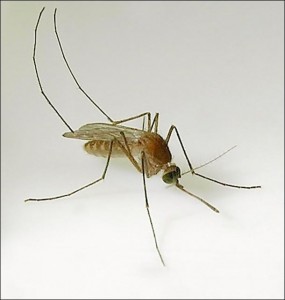
The Eastern equine encephalitis virus (EEEV) causes Eastern equine encephalitis (EEE) disease in birds, humans, horses, and other animals in the eastern United States, including Florida, which is especially receptive to the virus because of its freshwater hardwood swamps and wetlands, which provide good niches for the mosquito vectors of the disease. This 5-page fact sheet written by Samantha Wisely and Karen Hood and published by the UF/IFAS Department of Wildlife Ecology and Conservation describes the disease and includes strategies for limiting its spread.
http://edis.ifas.ufl.edu/uw453
Oxytetracycline hydrochloride (OTC-HCl) application for control of palm phytoplasmas
Phytoplasma diseases of palms are a major threat to the Florida nursery and landscaping industries. Historically, lethal yellowing has killed millions of coconut palms throughout the Caribbean and has been causing decline of over 30 species of palm in Florida since it was introduced to the state in the first half of the 20th century. In 2006, lethal bronzing disease was discovered on the west coast of Florida near Tampa. Currently, the only two management options available for control of phytoplasmas is an aggressive sampling strategy followed by consistent tree removal and injections of oxytetracycline hydrochloride, or OTC. This 2-page fact sheet written by Brian W. Bahder and Ericka E. Helmick and published by the UF/IFAS Entomology and Nematology Department seeks to provide a source of information and instruction on the injection of OTC into palm trunks.
http://edis.ifas.ufl.edu/in1240
Evolution, culture, and care for Betta splendens
The commercial betta, or Siamese fighting fish (Betta splendens), is one of a group of fishes that live in fresh water in Africa and southern Asia. Today’s commercial bettas are selected for bright colors as well as elaborate fins because the ornamental hobby is the main market for this species. This 5-page fact sheet written by Craig Watson, Matthew DiMaggio, Jeffrey Hill, Quenton Tuckett, and Roy Yanong and published by School of Forest Resources and Conservation, Program in Fisheries and Aquatic Sciences explains how to grow and care for these beautiful and fascinating fishes.
http://edis.ifas.ufl.edu/fa212
A Homeowner’s Guide to the Living Shoreline Permit Exemption Part 2: United States Army Corps of Engineers
Living shorelines are coastal shoreline stabilization interventions that rely on natural elements such as native vegetation and oyster reefs to protect property. The US Army Corps of Engineers, among other entities, regulates the placement of living shorelines through a permitting process to ensure project activities do not conflict with the public interest. In this 9-page guide, authors Savanna Barry, Sara Martin, and Eric Sparks provide you with example text for each application section that you can adapt to your needs to assist you in filling out the permit application. Published by the UF/IFAS Florida Sea Grant College Program.
http://edis.ifas.ufl.edu/sg189
How Red Tides Impact Manatees
One of Florida's keystone species, manatees help to maintain healthy coastal and riverine ecosystems and are economically important for many coastal communities. Effective protection measures implemented in Florida for many years allowed state and federal regulators to reclassify manatees from Endangered to Threatened in 2017. Red tides, especially persistent blooms during winter months, can be one of the largest killers of Florida manatees, and they may become endangered again if they are subjected to increased mortality and stress. Understanding how red tides affect manatees and how can you help is critical. This 5-page fact sheet written by Brittany Hall-Scharf and Armando Ubeda and published by the UF/IFAS Florida Sea Grant College Program will explain what red tides are, how they harm manatees, and what you can do to help.
http://edis.ifas.ufl.edu/sg188
A Homeowner’s Guide to the Living Shoreline Permit Exemption Part 1: Florida Department of Environmental Protection
“Living shoreline” is a term that describes coastal shoreline stabilization interventions that rely on natural elements such as native vegetation and oyster reefs to protect property. Living shorelines typically involve construction or placement of materials within state waters (public lands that occur waterward of the mean high tide line). The Florida Department of Environmental Protection and other entities regulate the placement of living shorelines through a permitting process to ensure project activities do not conflict with the public interest. To streamline the approval process for environmentally beneficial projects such as living shorelines, the DEP has defined an exemption for small-scale living shoreline projects that meet certain criteria. This 17-page fact sheet written by Savanna Barry, Sara Martin, and Eric Sparks and published by the UF/IFAS Florida Sea Grant College Program provides a guide to completing the exemption forms.
http://edis.ifas.ufl.edu/sg187
Economic Contributions of the Forest Industry and Forest-based Recreation in Florida in 2016
The state of Florida is half woods, with 26,807 square miles of forestland. Our extensive natural and planted pine and hardwood forests are used for production of a wide variety of wood building materials, consumer paper and packaging products, chemicals, and renewable biomass fuels. In addition to industrial forest-related activity, public forestlands in Florida support a variety of recreational activities, attract a significant number of recreational visitors, and provide many non-marketed environmental or ecosystem services. This 4-page fact sheet written by Christa Dean Court, Alan W Hodges, and Mohammad Rahmani and published by the UF/IFAS Food and Resource Economics Department describes a study that analyzed the economic contributions of the forest industry and forest-based recreation activities to the state of Florida in 2016.
http://edis.ifas.ufl.edu/fe1051
